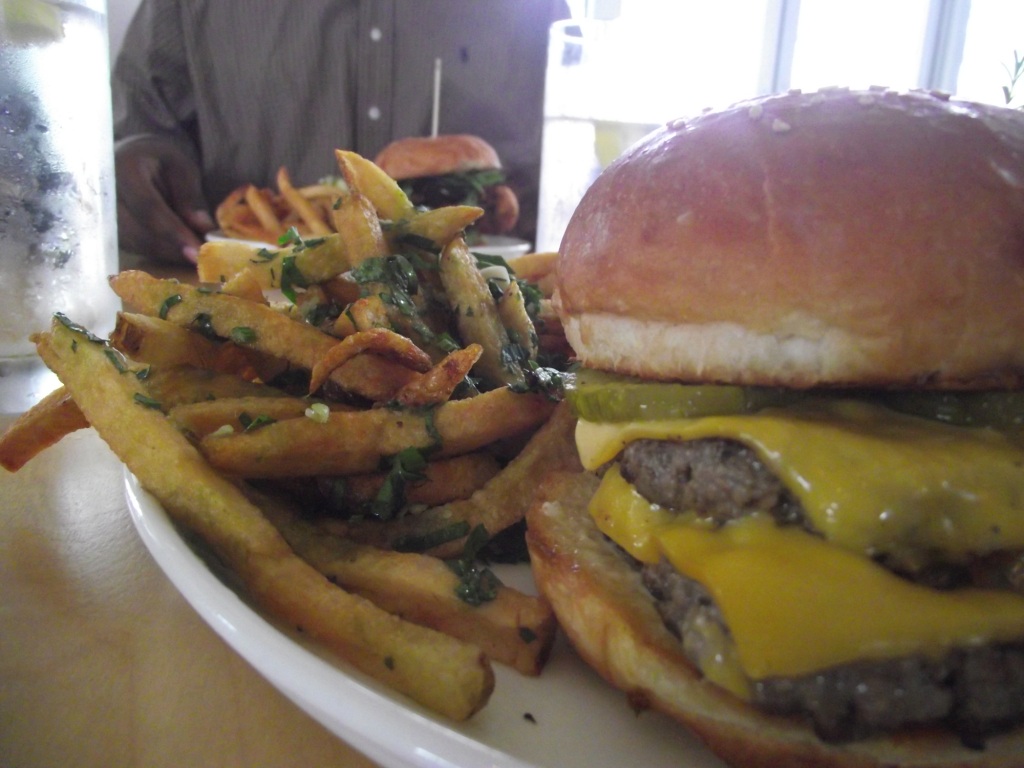Yes. It’s officially spring, but the weather in Atlanta apparently only got the first part of the memo. The sun is shining and the mulberry trees are beginning to bloom, but the temperature is toying with me. One minute it’s almost 70 degrees, the next it’s dipping into the 30s.
While waiting for the rest of spring to show up for good, I decided to whip up one last hearty stew of the season – a gumbo. It’s the perfect dish for beating the brrrs and more importantly it gave me a headstart on spring cleaning my fridge.
Ingredients:
- Flour – ½ cup plus
- Canola oil – ½ cup
- Celery – 2 stalks
- Onion – ½ large
- Bell pepper – ½ large
- Garlic – 1 Tbsp minced
- Gumbo seasoning – 2-3 Tbsp (see recipe below)
- Shrimp – ½ lb peeled, shells reserved for stock
- Smoked turkey sausage* – half of a 16 oz link, cut into small pieces
- Diced or petite diced tomatoes – 1 14.5 ounce can
- Worcestershire sauce – 2 teaspoons
- Okra – 12 ounce bag, frozen
- White rice
- Optional: Chicken, Tilapia
*I shared my batch with some friends who don’t eat mammals, hence the use of turkey sausage instead of andouille.
Gumbo seasoning mix:
I’m horrible with precise measurements, but here are all the things that I use in my blend, listed in descending order of quantity
- Thyme
- Paprika
- Cumin
- Chili powder
- Onion powder
- Cayenne pepper
- Old Bay
- Black pepper
- Seasoned salt
- Oregano
- Marjoram
- Nutmeg
Before starting the gumbo, take the shells from the peeled shrimp and add them to a small pot of water. Put the pot on very low heat while you make the rest of the gumbo. You’ll use this shrimp stock later.
The best and worst part of making gumbo is the first step – the roux. It’s the best because the thickening power of the roux is what separates a nice, hearty gumbo from a regular soup. But it’s the worst because it requires almost 30 minutes of constant stirring. I’ve had and prepared roux-less gumbo before and believe me, the time investment is definitely worth it. Besides giving your gumbo a good consistency, the roux helps the seasonings permeate evenly throughout the dish, and adds a depth to the end result that you simply will not get by dumping the spices in on their own. So, turn on some good music, roll up your sleeves and prepare to add some loving elbow grease. Luckily, I had my handy kitchen assistant to help me pass the time.
I start the roux with roughly equal parts flour and oil – for this batch I used ½ cup of canola and a little more than ½ cup of flour. Toss those in a pot over medium-high heat and get to stirring. I set my stove’s timer for 25 minutes, but you can pretty much tell time by the color of the roux itself. It will start out looking like this:
About halfway through, you’ll have something like this:
And when time’s up you should have something that’s the color of dark caramel, with a toasted, nutty smell to it. If it smells burnt, or gets black flecks in it, toss it and start over. If you use it, that burnt smell/taste will permeate your gumbo. Better to waste some flour, oil and a little time than a whole pot full of ingredients.
To the finished roux, I added my own gumbo seasoning, along with the celery, onion, bell pepper, and garlic. Stir those over medium high for 1-2 minutes, then add the turkey sausage. Cook this mixture for another few minutes, until the sausage begins to brown a bit. Next, stir in the tomatoes and the Worcestershire sauce and turn the heat down to low. You’ll notice the mixture will begin to thicken almost immediately. Add enough of the shrimp stock to bring to the desired consistency. I had some boneless, skinless chicken tenderloins in the freezer that I added at this point. Cover the pot and let everything simmer slowly for 25-30 minutes, stirring occasionally and adjusting the heat as needed. Sample a spoonful and add more seasoning as needed.
I also had a couple of frozen tilapia fillets on hand. I added these and the shrimp to the gumbo, then re-covered and let simmer for another 7-10 minutes. The final addition is the namesake of the dish: okra. Gumbo comes from the Bantu word for okra, ‘kingumbo’. I’ve found that people either love or absolutely hate okra, because of its so-called sliminess. When used in gumbo, the sliminess dissipates and actually helps thicken the dish – so even if you hate gumbo under normal circumstances, I’d be willing to bet you won’t even notice it here.
Once the okra has been added, cook the gumbo for another 5-10 minutes. Stir well before serving, so you can get a bit of everything in your bowl. Serve in a bowl with a mound of sticky, white rice.
This is a dish that only gets better with age. Serve it the next day if you have the patience. By day 2, the flavor will be so good, I GAH-ROWN-TEE that it’ll have you talking like dis here ol’ fella:
cheers,
k









Looks delish!